Monday, December 31, 2007
Thursday, December 27, 2007
Let Me Explain
Someone asked about cameras. I don’t know everything about cameras at all, but I know enough to go on long past the point where everything I’m saying is dull and useless.
I have a pretty cheap digital camera that’s enough to keep me happy. Officially, it’s a Canon A720 IS, available for about $200 if you look. You can spend a lot more on a fancier camera. Canon makes one or two cheaper cameras in the same line, and some more expensive variations of more or less the same thing before you get to their next tier of more fancy equipment.
I got this camera a couple of months ago because on my old camera I felt the automatic focus was no longer working perfectly, and there were a couple of dust spots that showed up consistently in every frame, and after traveling many hard roads with me the camera had been dropped enough times that it didn’t always know whether a picture was taken horizontally or vertically. The old camera still works, mostly. But it was nice to have the new one.
The new camera has a 6x zoom instead of a 3x zoom like the old one did. (That’s the optical zoom, not the digital zoom that goes beyond the optical.) The new camera takes pictures that are 3,264 x 2,448 pixels (8 megapixel); the old camera’s pictures were 2,272 x 1,704 (4 megapixel). That means that in a picture of the same size, there’s more detail. That means I can crop the picture tighter (to put online) or print it larger, with less graininess showing. When you combine the better zoom with the higher resolution image, you can grab a picture with much better detail from far off.
Properly working autofocus helps too, plus this camera has “image stabilization,” which means that if the camera moves slightly as I take a picture, it’s supposed to correct some of the blur. That should also be helping with sharp, clear details. I’m not sure how often it really adds anything.
Other than that, the new camera is very similar to the old one (which was also a Canon—I was happy with it, except that someone had mistreated it too often). When I compare pictures from the new to pictures from the old, I see exactly the difference suggested above: better detail in pictures. Sometimes the difference is dramatic.
Me, personally, I like a camera that runs on AA batteries. You can get ’em anywhere, and I have a few sets of rechargeables. Other people have other needs. You can find almost the identical feature set on other cameras (including a Canon line) that do not use AA cells. I specifically picked the camera that uses AAs.
I’ll mention in passing that this camera has a nice big screen on the back of it to let you see what you’re pointing at, or what picture you just took. I have seen cameras that take “better” pictures but have smaller view screens on the backs of them. That makes it really hard to tell whether you’re getting any worthwhile pictures when you’re on the road.
Other brands will offer similar features, and I’ve got nothing against other brands. Push comes to shove, I’d probably recommend getting at least 6-megapixel resolution, and the best optical zoom you can. (Ignore the digital zoom; it makes things bigger but grainier.) The one other note I’d insert is that when you’re in a hurry to snap a quick shot before it disappears, you sure do resent a camera that takes a few seconds to open up and be ready, as my Canon does. On the whole, though, I’m happy.
Technology is pretty good at replicating sound. It’s not perfect, but we can make pretty accurate reproductions of what something sounded like.
Technology has not caught up to the capabilities of human eyeballs. The eye is able to spot finer detail than a camera can (digital or film), and the eye adjusts better and faster to variations in brightness. Digital cameras have improved on the abilities of old film cameras, but they’ve still got a few generations of improvements before they capture things as naturally as our eyes do.
This is why you have to think a little, sometimes, when you’re taking a picture. Cameras give you automatic settings, but they also give you tools you can use to make up for the shortcomings of the automatic assumptions. Sometimes it’s as simple as knowing when to turn off the flash to catch a silhouette or the warmth of natural light. Sometimes you go a little further.
Beyond camera settings, I’m also not shy about accommodating further after the picture is taken, to make a thing look like what I saw. (I’m not proud either: Sometimes the camera shows me something better than what I was hoping to catch.)
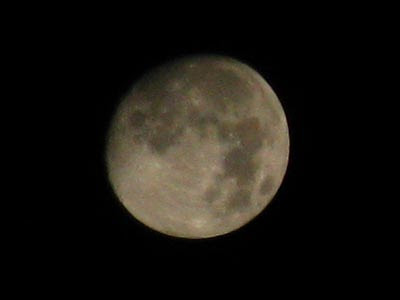 This was a picture I took (and posted) a few days ago. Better moon shot than my old camera could do. What I did not point out then was that this is the absolute limit my camera can reach with the optical zoom. Unlike most pictures I put up here, you can’t enlarge this any further. Here’s what the original frame looked like:
This was a picture I took (and posted) a few days ago. Better moon shot than my old camera could do. What I did not point out then was that this is the absolute limit my camera can reach with the optical zoom. Unlike most pictures I put up here, you can’t enlarge this any further. Here’s what the original frame looked like:
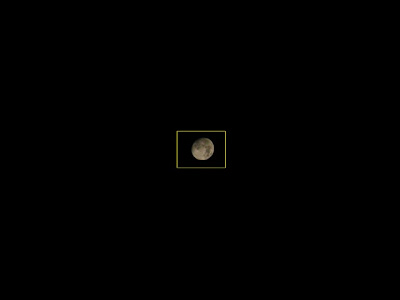 My camera has a 6x zoom and an 8-megapixel image resolution. It’s easy to find cameras with better lenses (10x zoom or 12x zoom) and higher image resolution (12 MP or 18 MP). You spend a little more. And, if your settings are right, you get better detail when you take pictures of the moon. (Note that to get this image I had to tell the camera to take the picture at a faster shutter speed than it wanted to use.)
My camera has a 6x zoom and an 8-megapixel image resolution. It’s easy to find cameras with better lenses (10x zoom or 12x zoom) and higher image resolution (12 MP or 18 MP). You spend a little more. And, if your settings are right, you get better detail when you take pictures of the moon. (Note that to get this image I had to tell the camera to take the picture at a faster shutter speed than it wanted to use.)
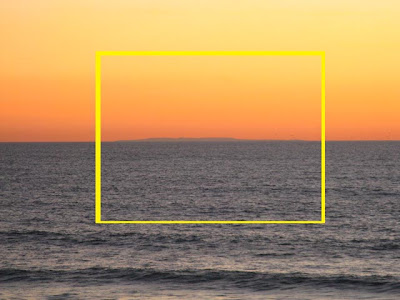 Here’s another recent example of tweaking a picture after I took it. Again, taking this picture at maximum (optical) zoom, there was a lot in the frame that wasn’t adding anything to the picture, so I lopped out what wasn’t helping. And then, for better or worse, I adjusted the color slightly, so the island would show up a little better. It made the water a richer blue, which maybe was aesthetically pleasing too:
Here’s another recent example of tweaking a picture after I took it. Again, taking this picture at maximum (optical) zoom, there was a lot in the frame that wasn’t adding anything to the picture, so I lopped out what wasn’t helping. And then, for better or worse, I adjusted the color slightly, so the island would show up a little better. It made the water a richer blue, which maybe was aesthetically pleasing too:
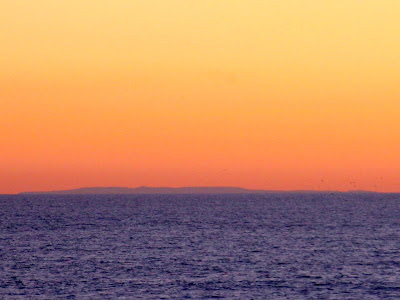
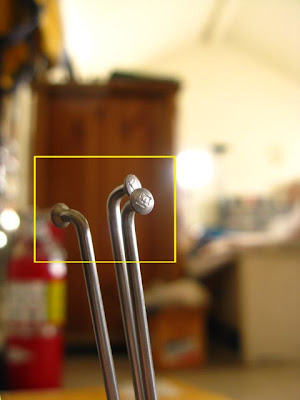 I actually kinda like the overall picture, with all the foreshortening from the forced angle, but there’s a lot of distraction in the frame (is that a fire extinguisher?), and what fascinated me was the detail in the stamping on the ends of the spokes. (That’s what they are.) This is a 19th-century technology refined down to be the most efficient solution for a particular need. You glance at a wheel and see spokes, and all you notice is they’re a bunch of wires, but they really show exquisite craftsmanship at a detailed level.
I actually kinda like the overall picture, with all the foreshortening from the forced angle, but there’s a lot of distraction in the frame (is that a fire extinguisher?), and what fascinated me was the detail in the stamping on the ends of the spokes. (That’s what they are.) This is a 19th-century technology refined down to be the most efficient solution for a particular need. You glance at a wheel and see spokes, and all you notice is they’re a bunch of wires, but they really show exquisite craftsmanship at a detailed level.
Also, I had just (accidentally) figured out how to correctly use the macro focus feature on the new camera. 21st-century technology let me grab images of the finest the 19th century had to offer. But then to call out the part I liked, I cropped out all the extraneous stuff from the frame. (This is all done on the computer, after the picture is already taken.) You end up with a simpler, cleaner shot that really pops out what I’m excited about:
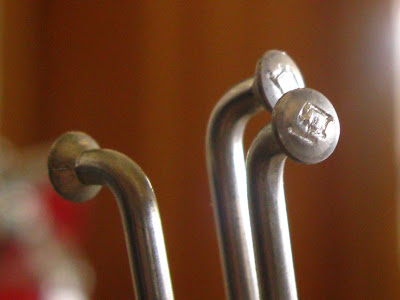
There’s nothing terribly interesting or photogenic about spokes. It would be easy enough to let the camera make all the calls, and end up with a picture like this:
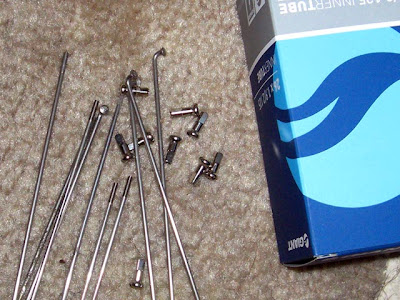 You pretty much know going in that you’re not going to end up with an Ansel Adams lithograph. And nine times out of ten, you’re going to end up using the camera’s automatic settings, either because they’re good enough or because you don’t have time to set up anything more crafty. But a tiny bit of advance thought every now and then might make a picture tell your story a little better.
You pretty much know going in that you’re not going to end up with an Ansel Adams lithograph. And nine times out of ten, you’re going to end up using the camera’s automatic settings, either because they’re good enough or because you don’t have time to set up anything more crafty. But a tiny bit of advance thought every now and then might make a picture tell your story a little better.
Stretching to try something new on one in ten pictures, even on throwaway shots, also is a good way to learn what the camera can do, so that when you run across a more meaningful shot that ought to be treated the same way, you know how to get there.
I have a pretty cheap digital camera that’s enough to keep me happy. Officially, it’s a Canon A720 IS, available for about $200 if you look. You can spend a lot more on a fancier camera. Canon makes one or two cheaper cameras in the same line, and some more expensive variations of more or less the same thing before you get to their next tier of more fancy equipment.
I got this camera a couple of months ago because on my old camera I felt the automatic focus was no longer working perfectly, and there were a couple of dust spots that showed up consistently in every frame, and after traveling many hard roads with me the camera had been dropped enough times that it didn’t always know whether a picture was taken horizontally or vertically. The old camera still works, mostly. But it was nice to have the new one.
The new camera has a 6x zoom instead of a 3x zoom like the old one did. (That’s the optical zoom, not the digital zoom that goes beyond the optical.) The new camera takes pictures that are 3,264 x 2,448 pixels (8 megapixel); the old camera’s pictures were 2,272 x 1,704 (4 megapixel). That means that in a picture of the same size, there’s more detail. That means I can crop the picture tighter (to put online) or print it larger, with less graininess showing. When you combine the better zoom with the higher resolution image, you can grab a picture with much better detail from far off.
Properly working autofocus helps too, plus this camera has “image stabilization,” which means that if the camera moves slightly as I take a picture, it’s supposed to correct some of the blur. That should also be helping with sharp, clear details. I’m not sure how often it really adds anything.
Other than that, the new camera is very similar to the old one (which was also a Canon—I was happy with it, except that someone had mistreated it too often). When I compare pictures from the new to pictures from the old, I see exactly the difference suggested above: better detail in pictures. Sometimes the difference is dramatic.
Me, personally, I like a camera that runs on AA batteries. You can get ’em anywhere, and I have a few sets of rechargeables. Other people have other needs. You can find almost the identical feature set on other cameras (including a Canon line) that do not use AA cells. I specifically picked the camera that uses AAs.
I’ll mention in passing that this camera has a nice big screen on the back of it to let you see what you’re pointing at, or what picture you just took. I have seen cameras that take “better” pictures but have smaller view screens on the backs of them. That makes it really hard to tell whether you’re getting any worthwhile pictures when you’re on the road.
Other brands will offer similar features, and I’ve got nothing against other brands. Push comes to shove, I’d probably recommend getting at least 6-megapixel resolution, and the best optical zoom you can. (Ignore the digital zoom; it makes things bigger but grainier.) The one other note I’d insert is that when you’re in a hurry to snap a quick shot before it disappears, you sure do resent a camera that takes a few seconds to open up and be ready, as my Canon does. On the whole, though, I’m happy.
Technology is pretty good at replicating sound. It’s not perfect, but we can make pretty accurate reproductions of what something sounded like.
Technology has not caught up to the capabilities of human eyeballs. The eye is able to spot finer detail than a camera can (digital or film), and the eye adjusts better and faster to variations in brightness. Digital cameras have improved on the abilities of old film cameras, but they’ve still got a few generations of improvements before they capture things as naturally as our eyes do.
This is why you have to think a little, sometimes, when you’re taking a picture. Cameras give you automatic settings, but they also give you tools you can use to make up for the shortcomings of the automatic assumptions. Sometimes it’s as simple as knowing when to turn off the flash to catch a silhouette or the warmth of natural light. Sometimes you go a little further.
Beyond camera settings, I’m also not shy about accommodating further after the picture is taken, to make a thing look like what I saw. (I’m not proud either: Sometimes the camera shows me something better than what I was hoping to catch.)
 This was a picture I took (and posted) a few days ago. Better moon shot than my old camera could do. What I did not point out then was that this is the absolute limit my camera can reach with the optical zoom. Unlike most pictures I put up here, you can’t enlarge this any further. Here’s what the original frame looked like:
This was a picture I took (and posted) a few days ago. Better moon shot than my old camera could do. What I did not point out then was that this is the absolute limit my camera can reach with the optical zoom. Unlike most pictures I put up here, you can’t enlarge this any further. Here’s what the original frame looked like: My camera has a 6x zoom and an 8-megapixel image resolution. It’s easy to find cameras with better lenses (10x zoom or 12x zoom) and higher image resolution (12 MP or 18 MP). You spend a little more. And, if your settings are right, you get better detail when you take pictures of the moon. (Note that to get this image I had to tell the camera to take the picture at a faster shutter speed than it wanted to use.)
My camera has a 6x zoom and an 8-megapixel image resolution. It’s easy to find cameras with better lenses (10x zoom or 12x zoom) and higher image resolution (12 MP or 18 MP). You spend a little more. And, if your settings are right, you get better detail when you take pictures of the moon. (Note that to get this image I had to tell the camera to take the picture at a faster shutter speed than it wanted to use.) Here’s another recent example of tweaking a picture after I took it. Again, taking this picture at maximum (optical) zoom, there was a lot in the frame that wasn’t adding anything to the picture, so I lopped out what wasn’t helping. And then, for better or worse, I adjusted the color slightly, so the island would show up a little better. It made the water a richer blue, which maybe was aesthetically pleasing too:
Here’s another recent example of tweaking a picture after I took it. Again, taking this picture at maximum (optical) zoom, there was a lot in the frame that wasn’t adding anything to the picture, so I lopped out what wasn’t helping. And then, for better or worse, I adjusted the color slightly, so the island would show up a little better. It made the water a richer blue, which maybe was aesthetically pleasing too:
One more example:
 I actually kinda like the overall picture, with all the foreshortening from the forced angle, but there’s a lot of distraction in the frame (is that a fire extinguisher?), and what fascinated me was the detail in the stamping on the ends of the spokes. (That’s what they are.) This is a 19th-century technology refined down to be the most efficient solution for a particular need. You glance at a wheel and see spokes, and all you notice is they’re a bunch of wires, but they really show exquisite craftsmanship at a detailed level.
I actually kinda like the overall picture, with all the foreshortening from the forced angle, but there’s a lot of distraction in the frame (is that a fire extinguisher?), and what fascinated me was the detail in the stamping on the ends of the spokes. (That’s what they are.) This is a 19th-century technology refined down to be the most efficient solution for a particular need. You glance at a wheel and see spokes, and all you notice is they’re a bunch of wires, but they really show exquisite craftsmanship at a detailed level.Also, I had just (accidentally) figured out how to correctly use the macro focus feature on the new camera. 21st-century technology let me grab images of the finest the 19th century had to offer. But then to call out the part I liked, I cropped out all the extraneous stuff from the frame. (This is all done on the computer, after the picture is already taken.) You end up with a simpler, cleaner shot that really pops out what I’m excited about:

There’s nothing terribly interesting or photogenic about spokes. It would be easy enough to let the camera make all the calls, and end up with a picture like this:
 You pretty much know going in that you’re not going to end up with an Ansel Adams lithograph. And nine times out of ten, you’re going to end up using the camera’s automatic settings, either because they’re good enough or because you don’t have time to set up anything more crafty. But a tiny bit of advance thought every now and then might make a picture tell your story a little better.
You pretty much know going in that you’re not going to end up with an Ansel Adams lithograph. And nine times out of ten, you’re going to end up using the camera’s automatic settings, either because they’re good enough or because you don’t have time to set up anything more crafty. But a tiny bit of advance thought every now and then might make a picture tell your story a little better.Stretching to try something new on one in ten pictures, even on throwaway shots, also is a good way to learn what the camera can do, so that when you run across a more meaningful shot that ought to be treated the same way, you know how to get there.
Wednesday, December 26, 2007
Tomorrow Is a Rest Day
 Funny things can happen when you go riding the day after Christmas. I headed for Laguna Beach today, a ride I haven’t taken in quite a while. I recalled that the full ride was 65 miles last time I estimated it. I intended to cut out a few miles at the south end, so I figured on going about 60.
Funny things can happen when you go riding the day after Christmas. I headed for Laguna Beach today, a ride I haven’t taken in quite a while. I recalled that the full ride was 65 miles last time I estimated it. I intended to cut out a few miles at the south end, so I figured on going about 60.I’ve been riding somewhat longer increments the past few days, though not really long enough to be ready for a 60-mile ride. But I was itching to test myself against the big old monster hill on Newport Coast Drive. It’s too long since I attacked it, and I was curious to see what my heart monitor would have to say about it.
 It was a beautiful day, though not quite as clear as it has been.
It was a beautiful day, though not quite as clear as it has been.I’m almost embarrassed to say how little attraction a White Christmas holds for me.
 It had been a great ride so far. The big hill went quite well; I paced myself on it (partly using the heart monitor to make sure I never went above a sustainable effort) and still had energy left by the end—though it was still a grunting grind to get up it. This time, the hill didn’t break me.
It had been a great ride so far. The big hill went quite well; I paced myself on it (partly using the heart monitor to make sure I never went above a sustainable effort) and still had energy left by the end—though it was still a grunting grind to get up it. This time, the hill didn’t break me.Somewhere around the southern end of the ride, I realized that I was not going to get home before sundown. Normally after a big effort, in the summer when the days are long, I don’t mind poking around slowly on the way home, stopping for lots of pictures. Today it looked as if I’d better keep mushing along, with no delays or easy pedaling.
Right around the same time, the wind also picked up. It had been coming from the south and east (naturally) when I was headed south and east. It flipped around and started coming from the west as soon as I turned around and started heading home.
I didn’t mind the wind switch; I have come to expect it in the late afternoon. But it seemed to be blowing with some vengeance. In fact, as I pushed harder and harder to beat the sundown, the wind stirred up all the more.
I didn’t check what speed it was blowing by the time I got home. I will say that in the last weary mile I popped my shoes out of the pedal clips in case a gust tried to knock me over. By 10 p.m. the wind was reported at 25 m.p.h.
 The sunset was really gorgeous, and it was also about 6 miles before I got home. I did get as far as I hoped to by sundown: There are a couple of long patches without good roadside light. After I cleared those, I knew I could get home safely. (The moon is full, but comes up a tiny bit after sundown.)
The sunset was really gorgeous, and it was also about 6 miles before I got home. I did get as far as I hoped to by sundown: There are a couple of long patches without good roadside light. After I cleared those, I knew I could get home safely. (The moon is full, but comes up a tiny bit after sundown.)Oh, and that 60-mile ride? After I got home, I was a little disappointed at how long it had taken me to go 60 miles. When I programmed it into MapMyRide.com, I found the ride I took today was really a tiny bit over 75 miles.
I was pretty beat by the end, but not demolished. After eating and drinking, I was very happy to sit still for quite a while. A hot shower felt good too. The wind was nowhere near as cold as what most of the country gets in winter, but it was no balmy zephyr either.
I wouldn’t do it if I didn’t enjoy it. I went out this morning to get tired and test my legs, and I did. Also had a great ride through some delightful scenery.
All the same, I think tomorrow I’ll stick to a shorter run.
Tuesday, December 25, 2007
Christmas in the Subtropics
 Yesterday for the third day in a row we could see San Clemente Island clearly off the coast. (This picture was taken a few days ago.) That’s about 50 miles of clear winter air. The temperature has been beautiful and mild, dropping at night to where it’s a wee bit chilly but warming up to around 70 degrees by day. The wind has been nearly calm, which is a nice Christmas gift for a bike rider.
Yesterday for the third day in a row we could see San Clemente Island clearly off the coast. (This picture was taken a few days ago.) That’s about 50 miles of clear winter air. The temperature has been beautiful and mild, dropping at night to where it’s a wee bit chilly but warming up to around 70 degrees by day. The wind has been nearly calm, which is a nice Christmas gift for a bike rider.In the picture above, at 50 miles, you can just barely see some kind of antenna array on the highest peak on the island. It almost looks like a defect in the lens or a bird flying by at just the right moment, but it shows up in other frames too.
The tradition is that when you can see San Clemente, it’ll rain within three days. So far, no such thing has been forecast for this week.
Merry Christmas!
Sunday, December 23, 2007
Ancient Relics
Saturday, December 22, 2007
Expose Yourself
 Leave a device to its own devices, and you won’t always love the results. Above is a picture of the moon, taken early this evening (sky still blue). The camera tried, as cameras will, to make the entire frame average out to about the brightness of a typical sunny day. As a result, the moon was seriously overexposed.
Leave a device to its own devices, and you won’t always love the results. Above is a picture of the moon, taken early this evening (sky still blue). The camera tried, as cameras will, to make the entire frame average out to about the brightness of a typical sunny day. As a result, the moon was seriously overexposed. So I changed the camera settings and forced it to take a faster shot. When I got to about 1/800 second, the exposure looked right. On the tiny camera screen, I didn’t notice that the moon was not in focus.
So I changed the camera settings and forced it to take a faster shot. When I got to about 1/800 second, the exposure looked right. On the tiny camera screen, I didn’t notice that the moon was not in focus.Friday, December 21, 2007
The Sun Also Sets
 Then the gratuitous camera demos.
Then the gratuitous camera demos.The shot above was taken with the new camera, just after sunset. That bridge is about 12.75 miles from the camera.
 And this is the frame from the new camera, at exactly 100%.
And this is the frame from the new camera, at exactly 100%.One day when I’m feeling ambitious, I’ll dig up an old negative and show the resolution from the same spot with 35mm film and a 300mm lens. My recollection is it was comparable to the old digital camera.
This is what the bridge looks like from a somewhat closer vantage:

Cut ’Em Off at the Pass
As someone who has on occasion paid tickets for being parked at expired meters—once while Christmas shopping for children’s books, no less, adding to my holiday fervor—I’ve never had trouble sympathizing with Paul Newman’s crime in Cool Hand Luke, which he described as “settling an old score.”
The law is there to protect us all, so of course I sympathize with it too. But I will note that when I lived in New York, I found the NYPD would not allow their parking enforcement crew to even use the same color cars as regular cops drove. The regular cops knew what people think of parking cops, and they wanted it to be clear that whatever you might think of the NYPD with its long history of graft, corruption, Mob influence, and occasional brutality, at least they weren’t parking cops.
I have to chuckle, then, at recent reports from Atlanta that not only has someone cut off the heads of 40% of the city’s parking meters, but the regular cops aren’t even investigating it as a crime.
The law is there to protect us all, so of course I sympathize with it too. But I will note that when I lived in New York, I found the NYPD would not allow their parking enforcement crew to even use the same color cars as regular cops drove. The regular cops knew what people think of parking cops, and they wanted it to be clear that whatever you might think of the NYPD with its long history of graft, corruption, Mob influence, and occasional brutality, at least they weren’t parking cops.
I have to chuckle, then, at recent reports from Atlanta that not only has someone cut off the heads of 40% of the city’s parking meters, but the regular cops aren’t even investigating it as a crime.
Tuesday, December 18, 2007
The Party of the First Part
Sunday, December 16, 2007
Doug Aroma
 You know those little pine-tree air fresheners (“There’s one in every car”) you see hanging from rear-view mirrors?
You know those little pine-tree air fresheners (“There’s one in every car”) you see hanging from rear-view mirrors?There’s an even better way to make your car smell good. Get the tree itself.
 It’s been a lot of years since I felt the urge to put up a Christmas tree. Most years over the past decades my plans have taken me away from home for the holidays. Back when I lived in New York, I sometimes put up a tree anyhow, if I was having a Christmas party that year. If I’ve put up a tree of my own since I moved to California, I don’t remember it.
It’s been a lot of years since I felt the urge to put up a Christmas tree. Most years over the past decades my plans have taken me away from home for the holidays. Back when I lived in New York, I sometimes put up a tree anyhow, if I was having a Christmas party that year. If I’ve put up a tree of my own since I moved to California, I don’t remember it.Someone told me the Douglas firs are the ones with the great smell. He said the Noble firs look fine, but they don’t smell the same.
 So far, I’ve got one gift to put under the tree, and an ornament for it. (I have other ornaments to hang on it, but I haven’t taken them out yet. Actually, I think I have some leftover gifts too from last year that I could put under the tree to help it feel festive.)
So far, I’ve got one gift to put under the tree, and an ornament for it. (I have other ornaments to hang on it, but I haven’t taken them out yet. Actually, I think I have some leftover gifts too from last year that I could put under the tree to help it feel festive.) Last year I was way too busy at this time of year to do much with decorations. This year I’ve picked up a couple of new ones. The theory is that if every year you get one or two new bright twinkly things, before long you’re that really obnoxious house with a totally commercial feel and no Christmas sincerity.
Last year I was way too busy at this time of year to do much with decorations. This year I’ve picked up a couple of new ones. The theory is that if every year you get one or two new bright twinkly things, before long you’re that really obnoxious house with a totally commercial feel and no Christmas sincerity. Christmas is a time for joy and brotherhood and community spirit. In the far corner of this picture you can see the balcony of Jaime and his wife. Jaime put out some new flashing ornaments this year, on his balcony. Christmas is not about competition. I got the new bright blue flashing snowflakes out of a sense of community spirit. We are all making the neighborhood more cheerful. Just because in this picture Jaime and his wife’s lights are smaller and further away, that doesn’t mean I’m trying to be bigger or better than they are.
Christmas is a time for joy and brotherhood and community spirit. In the far corner of this picture you can see the balcony of Jaime and his wife. Jaime put out some new flashing ornaments this year, on his balcony. Christmas is not about competition. I got the new bright blue flashing snowflakes out of a sense of community spirit. We are all making the neighborhood more cheerful. Just because in this picture Jaime and his wife’s lights are smaller and further away, that doesn’t mean I’m trying to be bigger or better than they are.Maybe next year I’ll get a blinking reindeer.
Subscribe to:
Comments (Atom)



























